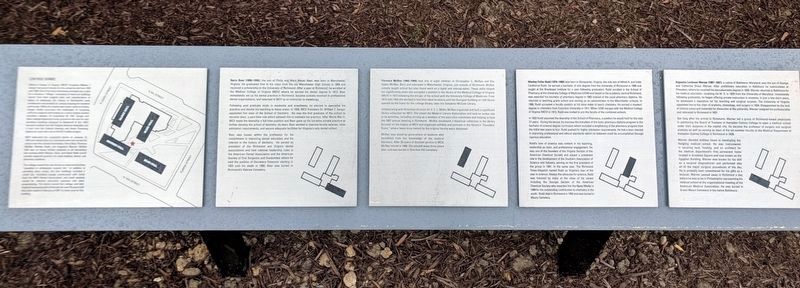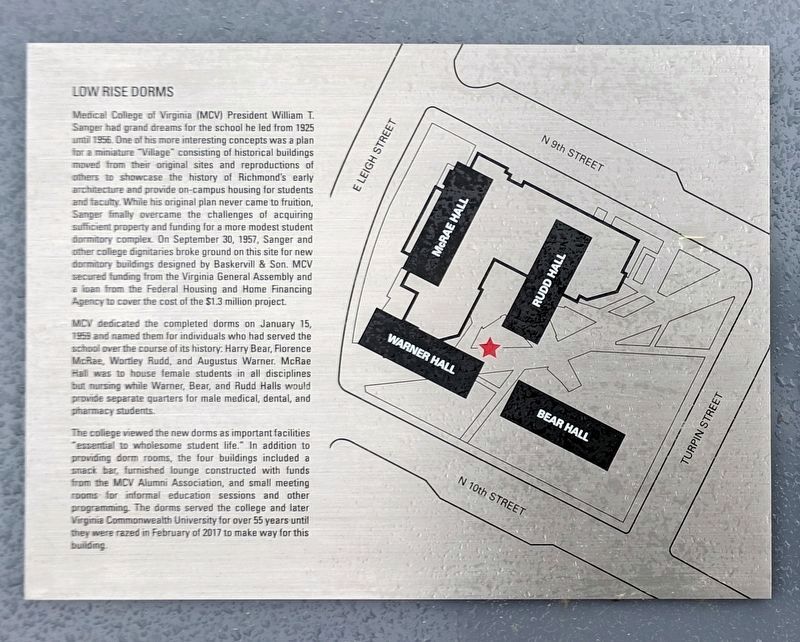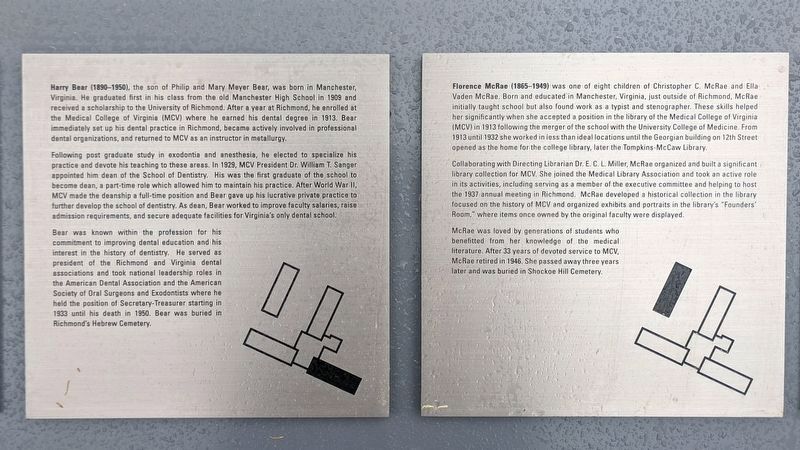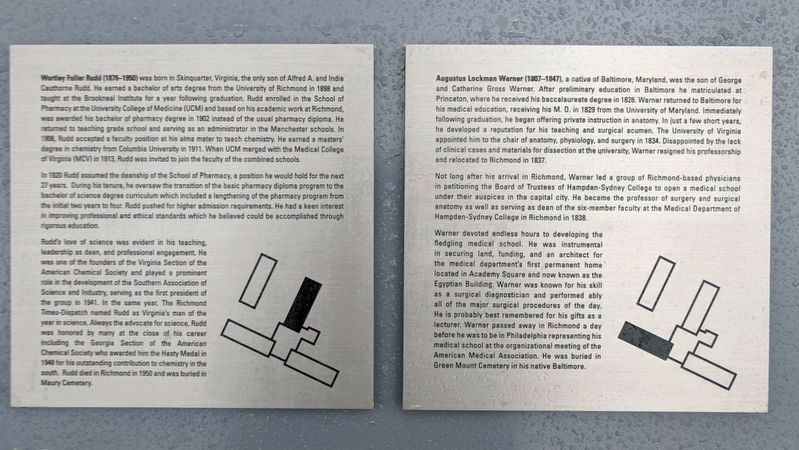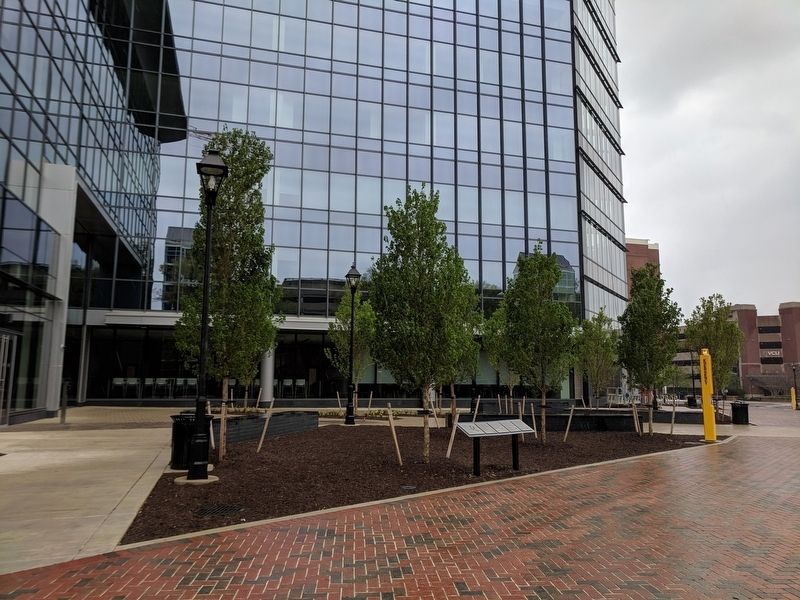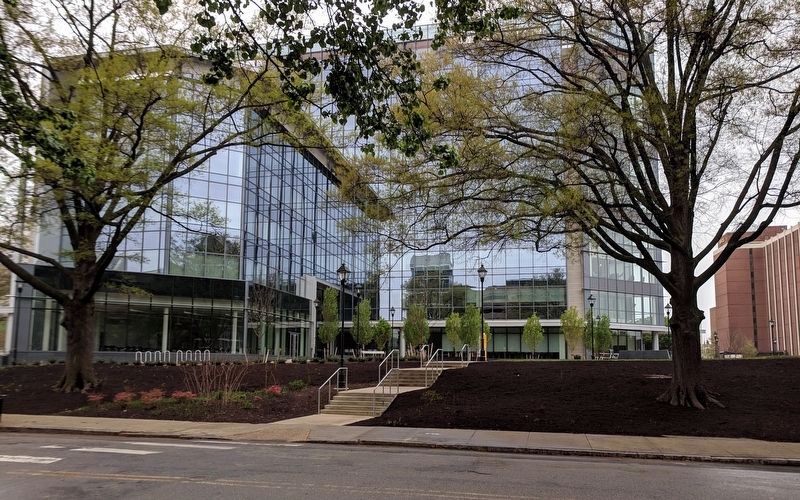Biotech and MCV District in Richmond, Virginia — The American South (Mid-Atlantic)
Low Rise Dorms
Low Rise Dorms
Medical College of Virginia (MCV) President Witham T. Sanger had grand dreams for the school he led from 1925 until 1956. One of his more interesting concepts was a plan for a miniature “Village” consisting of historical buildings moved from their original sites and reproductions of others to showcase the history of Richmond’s early architecture and provide on-campus housing for students and faculty. While his original plan never came to fruition, Sanger finally overcame the challenges of acquiring sufficient property and funding for a more modest student dormitory complex. On September 30, 1957, Sanger and other college dignitaries broke ground on this site for new dormitory buildings designed by Baskervill & Son. MCV secured funding from the Virginia General Assembly and a loan from the Federal Housing and Home Financing Agency to cover the cost of the $1.3 million project.
MCV dedicated the completed dorms on January 15, 1959 and named them for individuals who had served the school over the course of its history: Harry Bear, Florence McRae, Wortley Rudd, and Augustus Warner. McRae Hall was to house female students in all disciplines but nursing while Warner, Bear, and Rudd Halls provide separate quarters for male medical, dental, and pharmacy students.
The college viewed the new dorms as important facilities “essential to wholesome student life.” In addition to providing dorm rooms, the four buildings included a snack bar, furnished lounge constructed with funds from the MCV Alumni Association, and small meeting rooms for informal education sessions and other programming. The dorms served the college and later Virginia Commonwealth University for over 55 years until they were razed in February of 2017 to make way for this building.
(panel 2)
Harry Bear (1890-1950), the son of Philip and Mary Meyer Bear, was born in Manchester, Virginia. He graduated first in his class from the old Manchester High School in 1909 and received a scholarship to the University of Richmond. After a year at Richmond, he enrolled at the Medical College of Virginia (MCV) where he earned his dental degree in 1913. Bear immediately set up his dental practice in Richmond, became actively involved in professional dental organizations, and returned to MCV as an instructor in metallurgy.
Following post graduate study in exodontia and anesthesia, he elected to specialize his practice and devote his teaching to these areas. In 1929, MCV President Dr. William T. Sanger appointed him dean of the School of Dentistry. His was the first graduate of the school to become dean, a part-time role which allowed him to maintain his practice. After World War II, MCV made the deanship a full-time position and Bear gave up his lucrative private practice to further develop the school of dentistry. As dean, Bear worked to improve faculty salaries, raise admission requirements, and secure adequate facilities for Virginia's only dental school.
Bear was known within the profession for his commitment to improving dental education and his interest in the history of dentistry. He served as president of the Richmond and Virginia dental associations and took national leadership roles in the American Dental Association and the American Society of Oral Surgeons and Exodontists where he held the position of Secretary-Treasurer starting in 1933 until his death in 1950. Bear was buried in Richmond's Hebrew Cemetery.
(panel 3)
Florence McRae (1865-1949) was one of eight children of Christopher C. McRae and Ella Vaden McRae. Born and educated in Manchester, Virginia, just outside of Richmond, McRae initially taught school but also found work as a typist and stenographer. These skills helped her significantly when she accepted a position in the library of the Medical College of Virginia (MCV) in 1913 following the merger of the school with the University College of Medicine. From 1913 until 1932 she worked in less than ideal locations until the Georgian building on 12th Street opened as the home for the college library, later the Tompkins-McCaw Library.
Collaborating with Directing Librarian Dr. E. C. L. Miller, McRae organized and built a significant library collection for MCV. She joined the Medical Library Association and took an active role in its activities, including serving as a member of the executive committee and helping to host the 1937 annual meeting in Richmond. McRae developed a historical collection in the library focused on the history of MCV and organized exhibits and portraits in the library's "Founders' Room," where items once owned by the original faculty were displayed.
McRae was loved by generations of students who benefitted from her knowledge of the medical literature. After 33 years of devoted service to MCV, McRae retired in 1946. She passed away three years later and was buried in Shockoe Hill Cemetery.
(panel 4)
Wortley Fuller Rudd (1876-1950) was born in Skinquarter, Virginia, the son of Alfred A. and Indie Cauthorne Rudd. He earned a bachelor of arts degree from the University of Richmond in 1898 and taught at the Brookneal Institute for a year following graduation. Rudd enrolled in the School of Pharmacy at the University College of Medicine (UCM) and based on his academic work at Richmond, was awarded his Bachelor of Pharmacy degree in 1902 instead of the usual pharmacy diploma. He returned to teaching grade school and serving as an administrator in the Manchester schools. In 1906, Rudd accepted a faculty position at his alma mater to teach chemistry. He earned a masters' degree in chemistry from Columbia University in 1911. When UCM merged with the Medical College of Virginia (MCV) in 1913, Rudd was invited to join the faculty of the combined schools.
In 1920 Rudd assumed the deanship of the School of Pharmacy, a position he would hold for the next 27 years. During his tenure, he oversaw the transition of the basic pharmacy diploma program to the bachelor of science degree curriculum which included a lengthening of the pharmacy program from initial two years to four. Rudd pushed for higher admission requirements. He had a keen interest in improving professional and ethical standards which he believed could be accomplished through rigorous education.
Rudd’s love of science was evident in his teaching, leadership as dean, and professional engagement He was one of the founders of the Virginia Section of the American Chemical Society and played a prominent role in the development of the Southern Association of Science and Industry, serving as the first president of the group in 1941. In the same year, The Richmond Times-Dispatch named Rudd as Virginia's man of the year in science. Always the advocate for science, Rudd was honored by many at the close of his career including the Georgia Section of the American Chemical Society who awarded him the Hasty Medal in 1948 for his outstanding contribution to chemistry in the south. Rudd died in Richmond in 1950 and was buried in Maury Cemetery.
(panel 5)
Augustus Lockman Warner (1807-1847), a native of Baltimore, Maryland, was the son of George and Catherine Gross Warner. After preliminary education in Baltimore he matriculated at Princeton, where he received his baccalaureate degree in 1826. Warner returned to Baltimore for his medical education, receiving his M. D. in 1829 from the University of Maryland. Immediately following graduation, he began offering private instruction in anatomy. In just a few short years, he developed a reputation for his teaching and surgical acumen. The University of Virginia appointed him to the chair of anatomy, physiology, and surgery in 1834. Disappointed by the lack of clinical cases and materials for dissection at the university, Warner resigned his professorship and relocated to Richmond in 1837.
Not long after his arrival in Richmond, Warner led a group of, Richmond-based physicians in petitioning the Board of Trustees of Hampden-Sydney College to open a medical school under their auspices in the capital city. He became the professor of surgery and surgical anatomy as well as serving as dean of the six-member faculty at the Medical Department of Hampden-Sydney College in Richmond in 1838.
Warner devoted endless hours to developing the fledgling medical school. He was instrumental in securing land, funding, and an architect for the medical department's first permanent home located in Academy Square and now known as the Egyptian Building. Warner was known for his skill as a surgical diagnostician and performed ably all of the major surgical procedures of the day. He is probably best remembered for his gifts as a lecturer. Warner passed away in Richmond a day before he was to be in Philadelphia representing his medical school at the organizational meeting of the American Medical Association. He was buried in Green Mount Cemetery in his native Baltimore.
Erected 2019 by Virginia Commonwealth University.
Topics. This historical marker is listed in these topic lists: Architecture • Education • Science & Medicine. A significant historical date for this entry is September 30, 1957.
Location. 37° 32.621′ N, 77° 25.813′ W. Marker is in Richmond, Virginia. It is in the Biotech and MCV District. Marker is at the intersection of North 10th Street and East Leigh Street (Virginia Route 33), on the right when traveling north on North 10th Street. Located in front of the School of Allied Health Professions Building. Touch for map. Marker is at or near this postal address: 900 E Leigh St, Richmond VA 23298, United States of America. Touch for directions.
Other nearby markers. At least 8 other markers are within walking distance of this marker. Sadie Heath Cabaniss (about 400 feet away, measured in a direct line); Grant House / Sheltering Arms Hospital (about 700 feet away); Matthew Fontaine Maury (about 700 feet away); Maupin - Maury House (about 800 feet away); Valentine Museum (about 800 feet away); Wickham-Valentine House (approx. 0.2 miles away); The Edward V. Valentine Sculpture Studio (approx. 0.2 miles away); The Richmond Female Institute / Woman's College of Richmond (approx. 0.2 miles away). Touch for a list and map of all markers in Richmond.
Credits. This page was last revised on February 1, 2023. It was originally submitted on April 14, 2019, by Bernard Fisher of Richmond, Virginia. This page has been viewed 295 times since then and 33 times this year. Photos: 1, 2, 3, 4, 5, 6. submitted on April 14, 2019, by Bernard Fisher of Richmond, Virginia.
